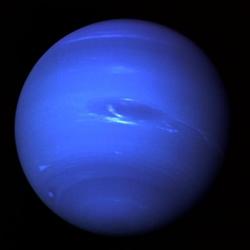This picture of Neptune was produced from the last whole-planet images taken through the green and orange filters on the Voyager 2 narrow-angle camera. The images were taken at a range of 4.4 million miles from the planet, 4 days and 20 hours before closest approach. The picture shows the Great Dark Spot and its companion bright smudge near the center of the image. On the west limb the fast moving bright feature called Scooter and the little dark spot are visible. These clouds persisted as long as Voyager’s cameras could resolve them.
NASA / JPL
Right now, Neptune can be found floating among the dim stars of Capricornus the Sea-Goat. Start by identifying the constellation’s triangular pattern, which looks like a bikini’s bottom half. The star Delta (δ) Capricorni marks the triangle’s northeastern corner. Zero in on it through your binoculars, and then move along the “waist” of the bikini — pass from Delta to Gamma, then stop at 4th-magnitude Iota. Look to the northwest of the star and you should see a turquoise-colored point of light.
Even though it will appear quite dim through binoculars, its color should help it stand out. You’ve found Neptune!










